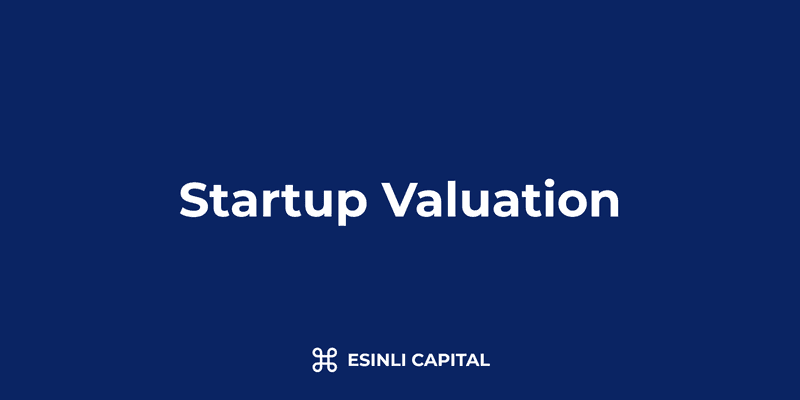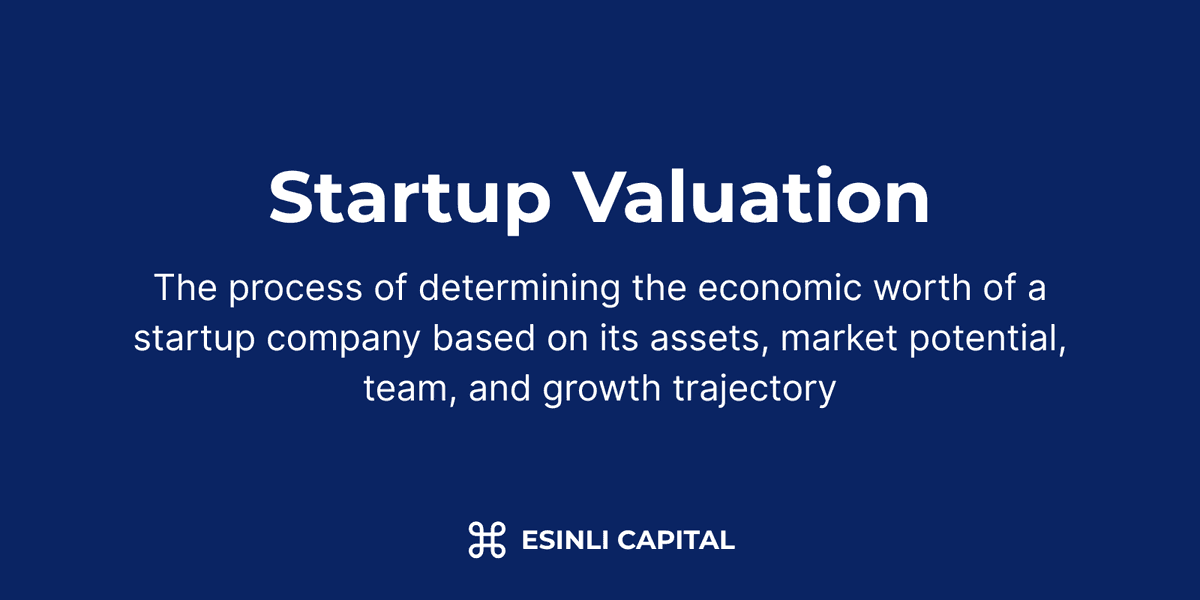In This Article
- How Do You Determine a Startup's Value?
- Startup Valuation Methods Explained
- How Stage of Development Affects Startup Valuation
- Startup Valuation Calculators and Tools
- Common Startup Valuation Mistakes to Avoid
- Pre-Money vs. Post-Money Valuation: What's the Difference?
- The Role of Investor Psychology in Startup Valuations
- How to Increase Your Startup's Valuation
- International Differences in Startup Valuation
- The Bottom Line
- FAQs
- How Do You Determine a Startup's Value?
- Startup Valuation Methods Explained
- How Stage of Development Affects Startup Valuation
- Startup Valuation Calculators and Tools
- Common Startup Valuation Mistakes to Avoid
- Pre-Money vs. Post-Money Valuation: What's the Difference?
- The Role of Investor Psychology in Startup Valuations
- How to Increase Your Startup's Valuation
- International Differences in Startup Valuation
- The Bottom Line
- FAQs

How to Value a Startup: Methods & Examples
KEY TAKEAWAYS
- Startup valuation methods vary by stage, with early-stage companies often using the Berkus Method or Scorecard Method, while later-stage startups rely more on Comparable Analysis and DCF.
- Pre-money valuation refers to a company's worth before investment, while post-money valuation equals pre-money plus the new investment amount—this distinction is crucial for understanding equity dilution.
- Market conditions significantly impact startup valuations, with regional differences showing Silicon Valley startups typically commanding 10-50% higher valuations than similar companies in other locations.
- The most effective approach combines multiple valuation methods to establish a reasonable range rather than fixating on a precise number—qualitative factors often outweigh financial projections for early-stage companies.
- Founders can increase valuation by focusing on key metrics (user growth, unit economics), building a strong team, creating competitive tension among investors, and securing strategic partnerships that validate the business model.
How Do You Determine a Startup's Value?
Valuing a startup presents unique challenges compared to established companies. Traditional valuation methods often fall short because startups typically lack substantial revenue history, may not be profitable, and operate in rapidly evolving markets. Despite these challenges, several methodologies have emerged to help founders, investors, and analysts determine reasonable valuations for early-stage companies.
The startup valuation process involves both quantitative analysis and qualitative assessment. Investors consider factors including the founding team's experience, market opportunity size, competitive landscape, intellectual property, traction metrics, and growth potential. While established companies are often valued based on earnings multiples, startups require more forward-looking approaches that account for high growth potential and significant uncertainty.
Startup Valuation Methods Explained
Startup valuations represent a critical junction where entrepreneurial optimism meets investor scrutiny. The right valuation balances the founder's need for capital without excessive dilution against the investor's requirement for appropriate risk-adjusted returns. Let's explore the most widely used methods for valuing startups at different stages.
The Berkus Method
Developed by angel investor Dave Berkus, this approach assigns monetary values to five key elements of early-stage startups:
- Sound Idea (basic value): Up to $1 million
- Prototype (technology risk reduction): Up to $1 million
- Quality Management Team (execution risk reduction): Up to $1 million
- Strategic Relationships (market risk reduction): Up to $1 million
- Product Rollout or Sales (production risk reduction): Up to $1 million
This method allows for a maximum pre-money valuation of $5 million, though these values can be adjusted based on the specific market and economic conditions. The Berkus Method is particularly useful for pre-revenue startups where financial projections would be highly speculative.
Key Advantage: Simplicity and focus on critical value drivers
Key Limitation: Somewhat arbitrary value assignments and ceiling limitation
Scorecard Valuation Method
The Scorecard (or Comparative) Method compares the target startup to similar funded startups in the same region and sector. The process follows these steps:
- Determine the average pre-money valuation for comparable pre-revenue companies
- Adjust this average based on the following factors:
- Management team (0-30%)
- Size of opportunity (0-25%)
- Product/technology (0-15%)
- Competitive environment (0-10%)
- Marketing/sales channels/partnerships (0-10%)
- Need for additional investment (0-5%)
- Other factors (0-5%)
Each factor receives a weight and rating compared to the average startup, producing a cumulative multiplier that's applied to the average valuation.
Key Advantage: Considers market realities and comparative strengths
Key Limitation: Requires good comparable data and subjective assessments
Venture Capital Method
Popularized by Harvard Business School professor Bill Sahlman, the Venture Capital Method follows this formula:
Pre-money Valuation = (Exit Value ÷ Expected ROI) - Investment Amount
Where:
- Exit Value = Projected Revenue × Industry P/E or Revenue Multiple
- Expected ROI = The return multiple investors seek (often 10-30x for early-stage investments)
For example, if a startup projects $50 million revenue in 5 years, the industry revenue multiple is 3x, the expected investor ROI is 10x, and the investment sought is $2 million:
Exit Value = $50 million × 3 = $150 million Pre-money Valuation = ($150 million ÷ 10) - $2 million = $13 million
Key Advantage: Forward-looking and aligned with investor return expectations
Key Limitation: Highly sensitive to exit projections and multiple assumptions
Risk Factor Summation Method
This method starts with an average pre-money valuation for comparable startups, then adjusts it based on 12 risk factors:
- Management risk
- Stage of business
- Funding/capital risk
- Manufacturing risk
- Sales and marketing risk
- Competition risk
- Technology risk
- Litigation risk
- International risk
- Reputation risk
- Potential lucrative exit
- Other factors relevant to the specific situation
Each factor is rated on a scale from -2 (very negative) to +2 (very positive), with each increment representing a $250,000 adjustment to the base valuation.
Key Advantage: Comprehensive risk assessment
Key Limitation: Challenging to quantify the dollar impact of risk factors
Discounted Cash Flow (DCF) Analysis
DCF calculates the present value of projected future cash flows using this formula:
Valuation = CF₁/(1+r)¹ + CF₂/(1+r)² + ... + CFₙ/(1+r)ⁿ + Terminal Value/(1+r)ⁿ
Where:
- CF = Cash flow in the specified year
- r = Discount rate (often 30-70% for startups)
- n = Number of projection years (typically 3-5)
- Terminal Value = Exit value calculation, often using a multiple approach
While DCF is standard in traditional finance, its application to startups requires careful consideration due to the high uncertainty in projections.
Key Advantage: Theoretically sound and widely accepted in finance
Key Limitation: Extremely sensitive to assumptions about growth rates, margins, and discount rates
Comparable Company Analysis
This method values startups based on similar companies' multiples:
- Identify comparable companies (public or recently acquired)
- Analyze relevant multiples (e.g., EV/Revenue, EV/User, EV/GMV)
- Apply appropriate multiples to the startup's metrics
For example, if comparable SaaS companies trade at 10x ARR (Annual Recurring Revenue) and the startup has $1 million ARR, its valuation would be approximately $10 million.
Key Advantage: Market-based and objective when good comparables exist
Key Limitation: Finding truly comparable companies for innovative startups
Cost-to-Duplicate Method
This approach estimates the cost to build an identical company from scratch, including:
- Physical assets
- Technology development costs
- Product design costs
- Team-building expenses
- Intellectual property value
- Brand value developed to date
Key Advantage: Rational floor valuation based on tangible and intangible assets
Key Limitation: Doesn't account for future growth potential or market opportunity
First Chicago Method
This sophisticated approach combines multiple scenarios:
- Best Case (optimistic scenario): Typically uses DCF or multiple-based valuation
- Base Case (expected scenario): Uses more conservative growth assumptions
- Worst Case (pessimistic scenario): Often values the company at liquidation value
The final valuation is a probability-weighted average of these three scenarios.
Key Advantage: Accounts for uncertainty with multiple scenarios
Key Limitation: Complexity and sensitivity to probability assumptions
How Stage of Development Affects Startup Valuation
The appropriate valuation method and expected ranges vary significantly depending on a startup's stage:
Pre-Seed/Idea Stage
At this earliest stage, valuation typically ranges from $250,000 to $2 million.
Common Methods: Berkus Method, Cost-to-Duplicate Key Value Drivers: Founding team experience, market opportunity size, prototype quality
Seed Stage
Companies with a minimum viable product (MVP) and early traction typically value between $2 million and $6 million.
Common Methods: Scorecard Method, Risk Factor Summation Key Value Drivers: Early user metrics, product differentiation, team completeness
Series A
Companies with proven product-market fit and scaling revenue typically value between $10 million and $30 million.
Common Methods: Venture Capital Method, Comparable Analysis Key Value Drivers: Revenue growth rate, unit economics, market expansion potential
Series B and Beyond
Companies with established business models and significant revenue typically value from $30 million upward.
Common Methods: DCF Analysis, Comparable Analysis, First Chicago Method
Key Value Drivers: Profitability trajectory, market share, competitive positioning
Startup Valuation Calculators and Tools
Several tools simplify the valuation process:
-
Venture Capital Valuation Calculator: These tools implement the VC method, requiring inputs like projected exit revenue, industry multiples, and expected ROI.
-
Scorecard Valuation App: Applications that facilitate comparative analyses against similar startups.
-
Pre-Money vs. Post-Money Calculators: These tools help founders understand dilution across multiple funding rounds.
-
Cap Table Management Software: Platforms like Carta and Pulley include valuation modeling functionality.
-
Discounted Cash Flow Templates: Specialized DCF models adjusted for startup valuation, incorporating higher discount rates and terminal multiple approaches.
When using calculators, remember they're only as good as their inputs. The best approach is to run multiple valuation methods and consider the range of outcomes rather than fixating on a single number.
Common Startup Valuation Mistakes to Avoid
1. Overemphasizing Financial Projections
Early-stage startups often develop detailed five-year projections that appear precise but are fundamentally speculative. While projections are necessary, they should be viewed as illustrating growth paths rather than making accurate financial predictions.
Solution: Focus on the key drivers and assumptions behind projections rather than the absolute numbers. Consider multiple scenarios with varying assumptions.
2. Ignoring Market Conditions and Comparables
Startup valuations don't exist in a vacuum. Market conditions, recent comparable funding rounds, and public market multiples significantly impact what investors will pay.
Solution: Research recent funding rounds for similar companies in your sector and stage. Understand current market sentiment toward your industry.
3. Valuing Too High in Early Rounds
While minimizing dilution is important, overly high early valuations can create problems for subsequent funding rounds if the company can't demonstrate sufficient growth to justify an increased valuation.
Solution: Consider the "next round test" - will you realistically achieve the metrics needed to raise at a higher valuation in 12-18 months?
4. Neglecting Post-Money Implications
Founders sometimes focus on pre-money valuation without fully understanding the post-funding ownership structure and control implications.
Solution: Use cap table modeling to visualize ownership after investment and through future rounds. Consider investor rights and governance changes alongside valuation.
5. Applying Inappropriate Valuation Methods
Using DCF analysis for a pre-revenue startup or basic Berkus method for a scaling Series B company can produce misleading valuations.
Solution: Choose valuation methods appropriate for your stage, and ideally use multiple approaches to establish a reasonable range.
Pre-Money vs. Post-Money Valuation: What's the Difference?
The distinction between pre-money and post-money valuation is critical for understanding equity dilution:
Pre-money valuation is the company's value before receiving new investment funds.
Post-money valuation is simply: Pre-money valuation + New investment amount
For example, if a startup has a pre-money valuation of $4 million and receives a $1 million investment, its post-money valuation becomes $5 million.
Ownership Calculation
The investor's percentage ownership is calculated as: Investment amount ÷ Post-money valuation
Using our example: $1 million ÷ $5 million = 20% ownership for the investor
Understanding these concepts becomes increasingly important as startups navigate multiple funding rounds, each with its own valuation implications.
The Role of Investor Psychology in Startup Valuations
Valuation isn't purely mathematical—investor psychology plays a significant role:
Anchoring Effect
The first valuation number mentioned often serves as an "anchor" influencing the negotiation. This is why many investors prefer entrepreneurs to name the first number.
Fear of Missing Out (FOMO)
Hot startups with multiple interested investors often secure higher valuations due to competition and FOMO among venture capitalists.
Pattern Recognition
Investors develop mental models based on their previous investments. Startups that fit familiar successful patterns often receive higher valuations.
Signaling Effect
Participation from prestigious investors can significantly boost valuation by signaling quality to other investors.
How to Increase Your Startup's Valuation
While avoiding unrealistic valuations, entrepreneurs can take several steps to maximize their company's worth:
1. Focus on Key Value Drivers
Different metrics matter at different stages:
- Early-stage: User growth, engagement metrics, technology differentiation
- Growth-stage: Revenue growth rate, customer acquisition cost (CAC), lifetime value (LTV)
- Late-stage: Path to profitability, market share, sustainable competitive advantages
2. Build a Strong Team
Investors often say they invest in people first. A team with relevant domain expertise, previous startup success, and complementary skills can command a premium valuation.
3. Create Competitive Tension
Having multiple interested investors improves negotiating leverage. Consider running a structured fundraising process rather than sequential one-off conversations.
4. Demonstrate Market Understanding
Show detailed knowledge of your market size, competitive landscape, and specific customer pain points. This builds investor confidence in your growth projections.
5. Intellectual Property Protection
Patents, trade secrets, and other IP protections can significantly increase valuation by creating barriers to entry.
6. Strategic Partnerships
Relationships with established companies validate your business model and can accelerate growth, positively impacting valuation.
International Differences in Startup Valuation
Valuation norms vary significantly by geography:
Silicon Valley
Traditionally commands the highest valuations due to the concentration of venture capital, talent, and exit opportunities. SaaS companies might see 15-20x ARR multiples at growth stage.
New York and Boston
Strong ecosystems with valuations typically 10-30% lower than Silicon Valley, though the gap has narrowed in recent years.
Europe
European startups historically received lower valuations than US counterparts, often 30-50% less for comparable metrics. This gap is narrowing, particularly for companies with global ambitions.
Asia
Varies significantly by country, with China and India seeing valuation approaches increasingly similar to US standards for high-growth tech companies.
Entrepreneurs should benchmark against regional comparables while understanding these differences when raising from international investors.
The Bottom Line
Startup valuation remains both art and science. The most effective approach combines multiple valuation methods to establish a reasonable range rather than fixating on a precise number. For early-stage startups particularly, qualitative factors like team strength, market opportunity, and competitive differentiation often carry more weight than financial projections.
For founders, understanding these methods helps in fundraising negotiations and strategic planning. For investors, these approaches provide frameworks to evaluate potential returns against risks. As startups mature, valuation methods typically shift from qualitative assessments toward more traditional financial metrics.
The key is maintaining perspective: valuation is ultimately a negotiated compromise that should allow both entrepreneurs and investors to achieve their goals. The best valuations create alignment between founders and investors, establishing a foundation for the partnership needed to build a successful company.
FAQs
What's a realistic valuation for a pre-revenue startup?
Pre-revenue startups typically value between $1 million and $5 million, depending on the team's experience, market opportunity, prototype quality, and intellectual property. In hot sectors like AI or biotechnology, valuations can sometimes exceed these ranges.
How do VCs determine startup valuation?
VCs typically consider multiple factors: team quality, market size, competitive landscape, traction metrics, business model, and comparable company valuations. They often use the Venture Capital Method, calculating backward from expected exit values while considering the return multiple they need to achieve fund-level performance targets.
Does geography affect startup valuation?
Yes, significantly. Silicon Valley startups typically command the highest valuations, followed by other major US tech hubs. European valuations have historically been 30-50% lower than US equivalents, though this gap is narrowing. Regional investor expectations, exit opportunities, and talent markets all contribute to these differences.
Should I use a startup valuation calculator?
Valuation calculators can provide useful starting points, but should never be the sole determinant of your startup's worth. The best approach is using multiple valuation methods, understanding the assumptions behind each, and developing a reasonable valuation range rather than a single number.
How do I justify a higher valuation to investors?
Focus on demonstrating progress in key metrics (user growth, revenue, engagement), building competitive advantages, reducing execution risk through a strong team, and creating competitive tension among potential investors. Be prepared to support your valuation with comparable company data and clear articulation of your growth trajectory.



